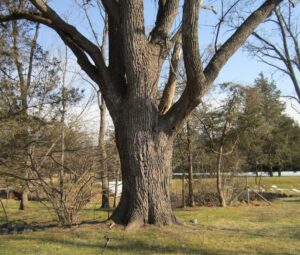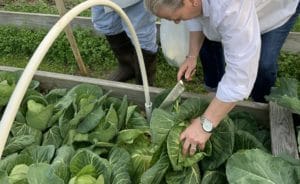Hello fellow readers, Last week, I had the privilege of visiting with Elisabeth, who moved back to Blairstown from Chicago to be near her family. She purchased a farm built in the 1800s and is amid renovating and restoring the house and barn. Elisabeth wishes for a landscape design filled with native plants and natural hardscape materials to enhance the gorgeous property’s views and function while being kind to the wildlife—music to my ears!
There are two stunning native black walnut trees; one is a grand focal point. Next to it is a remnant foundation that Elisabeth would like to use as a boundary around dwarf fruit trees. Or, it could serve as a border for a vegetable garden. So on with the investigative hat to find out what fruits and veggies will thrive in the vicinity of the black walnut.
Black Walnut trees produce an herbicide called juglone.
Eastern black walnut (Juglans nigra) are fascinating trees as they produce juglone, a natural herbicide making them allelopathic—a fancy word for emitting chemicals that harm other plants. The chemical gives black walnuts an advantage over non-tolerant plants competing for resources. All parts of the tree contain it, including the roots.
Juglone inhibits the ability of susceptible plants to take up nutrients and water. Symptoms include yellowing and wilting leaves first on new growth, then throughout the plant stunting its growth or killing it.
Locate fruits and veggies non-tolerant of Black Walnut 50 to 80 feet away.
While the greatest concentration of juglone is under the canopy, known as the tree’s dripline, the roots go way beyond that; essentially, roots grow as wide as the tree’s height. Plus, the natural herbicide can leach into rainwater that encounters fallen leaves, branches, and decaying nuts. Therefore, it’s best not to locate any plants that cannot survive juglone within 50 to 80 feet. And, perhaps it is evident, don’t add remnants from black walnut trees into your compost or mulch used around non-tolerant plants.
Fruit trees that can thrive despite juglone include cherry, plum, peach, and nectarine. Shrubs such as quince and black raspberry will also do well. Sadly, favorites such as pears and apple trees, blueberry and blackberry bushes will suffer or die if planted near black walnut. The same is true of many vegetables such as tomatoes, eggplant, potatoes, peppers, peas, asparagus, cabbage, and rhubarb.
Use raised beds for veggies non-tolerant of black walnut.
Workarounds for your favorite veggies, if space is limited preventing a garden far from the walnuts, are installing raised beds. Add weed barrier fabric before adding the soil to the raised beds to avoid walnut roots from invading. Be sure the beds are beyond the risk of falling debris, and add plenty of compost to assure good drainage.
Potted gardens are ideal as the pots themselves provide the barrier to entering roots. Or, choose vegetables tolerant of juglone, including beets, corn, carrots, cauliflower, melons, squash, soybeans, parsley, snap beans, lima beans, onions, garlic, leeks, parsnip, and parsley.
It takes several years for the roots of fallen black walnut to decay and lose their toxicity, so removing them is not a quick fix. Not that I would ever suggest removing Elisabeth’s glorious trees.
 Black Walnuts make magnificent shade trees.
Black Walnuts make magnificent shade trees.
Indeed, the native tree’s beefy husked nuts can be a tad problematic, especially if you happen to be below one when it falls. Much like being beaned by shagbark hickory nuts while gardening below them that first spring I arrived. Talk about an element of surprise! But it came with a good laugh. (Shagbarks, by the way, also produce juglone, but not to the level of black walnut.)
Besides being beautiful, black walnuts and shagbark hickories feed wildlife and are also edible to those of us willing to tackle their thick husks.
Garden Dilemmas? AskMaryStone@gmail.com (and now on your favorite Podcast App.
You’ll enjoy a related column titled Juglone Companion Plants.
And tune in to the Garden Dilemmas Podcast featuring this story.
Helpful Plant Lists tolerant of Black Walnut :
University of Wisconsin-Extension





As we’ve discussed, we planted tomato plants under our walnut tree, and we were very disappointed with the results. That was several years ago, and we never did it again! Forsythia does well under it, however.
Hi Diane, Thank you for sharing your experience. It’s a matter of picking the right companions. Just like in life :^). Thank you for reading my column! Mary